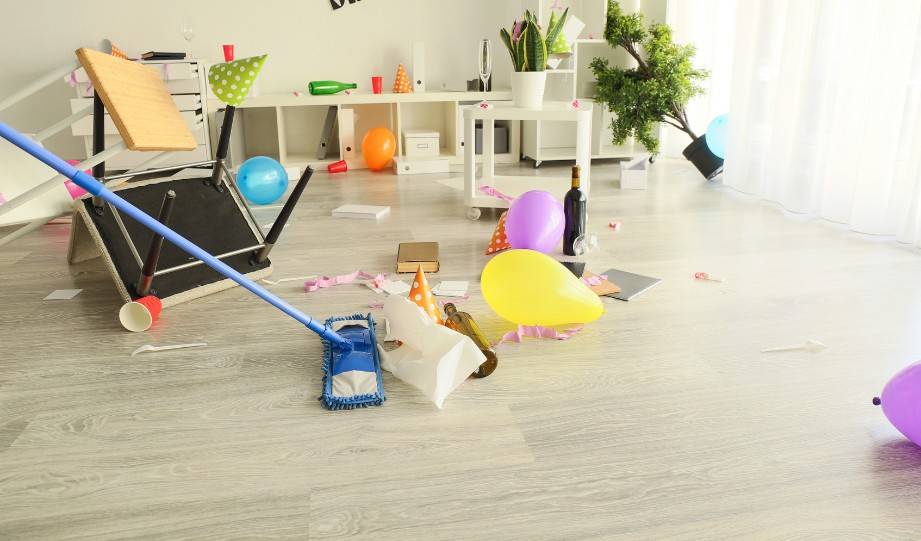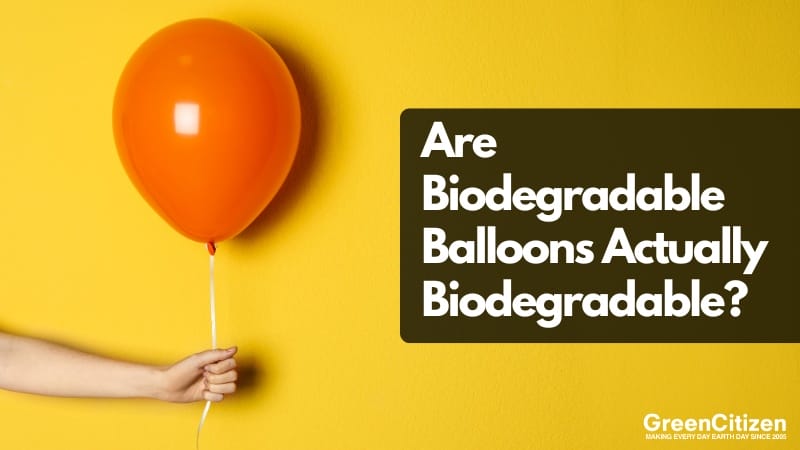Are biodegradable balloons truly biodegradable? Many party suppliers claim these “eco-friendly balloons” break down quickly and leave no environmental trace. But the truth is far less cheerful.
Each year, millions of balloons — including so-called sustainable balloons — end up in landfills or oceans. Studies show that even biodegradable latex balloons can take months or years to break down, posing risks to wildlife along the way.
Whether you’re planning a green celebration or searching for compostable balloons, understanding their real environmental impact is essential.
This guide cuts through marketing myths and explores the facts about biodegradable helium balloons, water balloons, and other eco-friendly balloon alternatives — so you can celebrate without harming the planet.
Key Takeaway: Are Biodegradable Balloons Actually Biodegradable?
Biodegradable balloons are not truly biodegradable. Studies show latex balloons can remain intact for months in compost and over five years in natural conditions. During this time, they pose severe risks to wildlife. Eco-friendly celebrations are best with sustainable, balloon-free decorations.
Are There Biodegradable Balloons?
The short answer: No — there are no balloons that are truly biodegradable. Many are marketed as eco-friendly balloons, sustainable balloons, or compostable balloons because they’re made from natural latex, a material that can biodegrade under certain conditions.
But that’s an overly simplistic claim. In reality, independent studies show latex balloons can take months or years to break down, and during that time, they remain a serious hazard to wildlife.

Why the “Biodegradable Latex Balloon” Claim Is Misleading
In 1989, a balloon industry–sponsored study claimed latex balloons were safe for the environment. The report concluded that most helium-filled balloons burst into small pieces and would decompose “as fast as an oak leaf.”
However, the study had several flaws: it was never peer-reviewed, did not disclose its testing methods, and relied on industry funding.
More recent tests — such as those conducted by environmental researchers at the University of Tasmania — found latex balloons showed no measurable degradation after 16 weeks in soil or marine conditions.
This directly contradicts the marketing claims of biodegradable helium balloons and other so-called “eco balloons.”
What Really Happens When Biodegradable Balloons Break Down
While an oak leaf may decompose in several months without harming animals, latex balloons behave differently. Their rubbery texture and elasticity remain intact during decomposition, making them a choking hazard for small animals.
Larger animals are also at risk — balloon fragments can block digestive tracts, leading to starvation. Even tiny pieces of recyclable balloons or biodegradable water balloons can cause internal injuries.
This makes the concept of balloons being environmentally friendly a form of greenwashing. Understanding the slow breakdown rate and the ongoing harm to wildlife is key before considering balloons as part of any eco-friendly celebration.

Can Latex or Plastic Balloons Be Recycled?
Technically yes — but recycling balloons is rarely practical or widely available. Balloons made from synthetic plastics or natural latex are difficult to process because most household recycling facilities cannot separate or break down these stretchy, rubbery materials.
While some specialized programs accept recyclable balloons, they are few and far between, and contamination from dyes or metallic coatings can make the process unfeasible. This means that even eco-friendly balloons marketed as “recyclable” often end up in landfills or as litter.
If you want to dispose of balloons responsibly, the most sustainable choice is to avoid them altogether or look for reusable alternatives, such as fabric bunting or paper decorations.
Why Balloons Are So Difficult to Recycle
Most latex and plastic balloons cannot be recycled through regular municipal programs because they contain synthetic additives, dyes, and plasticizers. Even balloons labeled as eco-friendly balloons or recyclable balloons are rarely accepted at recycling facilities.
While it is technically possible to process natural latex and blend it with synthetic materials, the result is often polystyrene — a plastic that is even less recyclable and more environmentally persistent.
According to waste management research, once latex is mixed with these chemicals, it no longer qualifies as raw latex and loses its compostable or recyclable properties.
The truth is, the “natural latex” in most sustainable balloons is far from pure by the time it reaches consumers. These added chemicals not only make recycling nearly impossible but also contribute to the broader issue of greenwashing in balloon marketing.
Next, we’ll look at how long balloons actually take to decompose — and why their environmental impact doesn’t end after the party is over.
✅ TL;DR: Most latex and plastic balloons can’t be recycled because they contain synthetic additives and dyes. Even when processed, they often turn into polystyrene — a plastic that’s even harder to recycle and worse for the environment.
How Long Do Biodegradable Balloons Take to Decompose?
Independent studies show biodegradable latex balloons can remain intact for months — even years — far beyond compostable material standards. This means they fail to meet recognized definitions of eco-friendly balloons or compostable balloons.
What Makes Something Compostable?
To be classified as compostable, a material must biodegrade naturally within a specific timeframe. Under EN 13432 industrial composting standards, it must:
- Disintegrate within 12 weeks
- Be indistinguishable from surrounding soil after decomposition
Biodegradable balloons, however, don’t come close to this standard in real-world conditions.
How Biodegradable Balloons Performed in a 16-Week Industrial Composting Test (University of Tasmania)
Researchers Morgan Gilmour and Jennifer Lavers at the Institute for Marine and Antarctic Studies, University of Tasmania conducted a controlled experiment to see how biodegradable latex balloons break down under ideal composting conditions.
They placed several colorful latex balloons into an industrial compost heap maintained at high heat and moisture — the type of environment designed to accelerate organic decomposition. The heap was regularly turned to encourage microbial activity, simulating the fastest possible breakdown scenario.
After 16 weeks in an industrial compost heap, we unearthed blue and white balloons and found them totally unscathed. The knots we spent hours painstakingly tying by hand more than four months ago were still attached, and sparkly blue balloons still glinted in the sun.
— Morgan Gilmour, Adjunct Researcher in Marine Science, University of Tasmania
Industrial Composting Test Results
Even after four weeks beyond the 12-week compostability standard, the balloons were intact, elastic, and visually unchanged — more than enough time for wildlife to encounter them.
Long-Term Natural Exposure Test — Balloons Blow (5 Years)
The nonprofit Balloons Blow ran a longer-term experiment to simulate what happens after a typical balloon release. Two latex balloons were placed on garden soil in December 2011 without special composting.
Results after 5 years:
- Balloons were still recognizable
- Degradation was minimal
- Nowhere near meeting compostable criteria
The group also noted that oak leaves can take up to 4 years to fully degrade, challenging the balloon industry’s frequent comparisons to leaf decomposition.
TL;DR: Are Biodegradable Balloons Compostable?
Even in industrial composting, biodegradable latex balloons showed no breakdown after 16 weeks, and in natural soil, they persisted for over 5 years. These findings prove that so-called eco-friendly balloons fail to meet compostable standards and remain a threat to wildlife long after use.
What Are the Best Eco-Friendly Alternatives to Biodegradable Balloons?
The best eco-friendly alternatives to biodegradable balloons include paper bunting, fabric flags, fresh or dried flowers, paper lanterns, tissue pom-poms, and reusable banners. These options create festive, eye-catching décor while being sustainable and often reusable.
Paper Bunting and Fabric Flags
Colorful paper bunting or fabric flags can create the same celebratory atmosphere as balloons without the waste. Choose recycled paper or organic cotton for a truly sustainable decoration.
Fresh or Dried Flowers
Bouquets, garlands, or table arrangements made from fresh or dried flowers bring natural beauty to any event. Dried blooms, in particular, can be reused for months.
Paper Lanterns
Reusable paper lanterns add charm and color to both indoor and outdoor celebrations. Opt for ones made from biodegradable rice paper for a compostable decoration option.
Pom-Poms and Tissue Decorations
Made from recycled tissue paper, pom-poms are lightweight, colorful, and easy to store for reuse.
Reusable Banners and Signs
Invest in a custom fabric banner or chalkboard sign that can be used year after year — perfect for birthdays, weddings, and seasonal events.
Frequently Asked Questions (FAQ)
No, mylar balloons don’t decompose. Mylar is a synthetic product that will never biodegrade. Unfortunately, it’s a material that you’ll find in too many household items and many companies still make balloons with this pollutant.
No, there are no biodegradable water balloons because all balloons are either made of mylar or a highly processed form of latex. While you can technically compost latex, the way companies mix it with chemicals and synthetic plastics makes it a substance that won’t easily break down.
No, foil balloons are not biodegradable. They are made from a synthetic type of nylon that makes them air and watertight. It’s also not possible to recycle them as you cannot easily extract the materials that make them shiny.
Over 100,000 marine mammals are killed each year by balloons according to some estimates published by the NY Times. What’s shocking is that 5% of dead sea turtles had latex balloons in their stomach, leading to starvation.
Balloons are made of rubber, but it’s important to also note that they often contain plasticizers. These synthetic and chemical compounds make natural rubber and latex softer and more durable, but they also make the balloons less biodegradable.
Why Biodegradable Balloons Aren’t the Answer — and What to Use Instead
Independent tests prove there is no such thing as a truly biodegradable balloon. Biodegradable latex balloons and eco-friendly balloons can remain intact for months or even years, posing severe risks to wildlife.
The University of Tasmania’s 16-week composting study and Balloons Blow’s 5-year soil test both found that latex balloons failed to break down within compostable standards. During that time, they remain elastic, hazardous, and deadly to animals that ingest them.
If we want to protect the environment and wildlife, it’s time to replace balloons with sustainable decorations like paper bunting, fabric flags, flowers, lanterns, and reusable banners.

